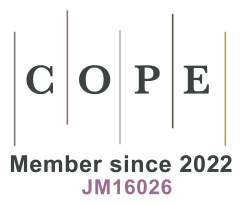Comparison of the therapeutic effects of ulif and plif in the treatment of lumbar spondylolisthesis
Abstract
Purpose: To compare the therapeutic effects of unilateral biportal endoscopic lumbar interbody fusion (ULIF) and posterior lumbar interbody fusion (PLIF) in the treatment of lumbar spondylolisthesis. Method: To retrospectively analyze the clinical data of 66 patients with lumbar spondylolisthesis in Qianfoshan Hospital of Shandong Province, 31 cases were treated with ULIF (ULIF group) and 35 cases were treated with PLIF (PLIF group). The operation time, intraoperative blood loss, hospitalization days, postoperative complications, low-back pain vas scores, and odi scores, were all measured. The operation time, intraoperative blood loss, postoperative drainage volume, hospitalization days, postoperative complications, low-back pain vas scores, and Oswestry Disability Index (ODI) were compared between the two groups. Results: The operation time in the ULIF group was longer than that in the PLIF group, and the difference was statistically significant (p < 0.05). There were statistically significant differences in intraoperative blood loss, postoperative drainage volume, and hospital stay (p < 0.05). There were 1case of cerebrospinal fluid leakage in the ULIF group, and 1 cases of infection in the PLIF group. No other complications occurred. The difference in the incidence of complications between the two groups was statistically significant (p < 0.05). Patients in both groups were followed for 6 months. Conclusion: For patients with lumbar spondylolisthesis, ULIF group can achieve similar efficacy to PLIF group. They are similar in terms of pain relief and improvement in functional disability. ULIF has less intraoperative and postoperative bleeding and shorter hospitalization days, lower infection rate and less damage to muscle tissue. However, ULIF takes a long time, has a long learning curve and requires expensive equipment, Surgeons and patients need to undergo more X-ray fluoroscopy sessions.
References
1. Wan J, Wang N, Bei C, et al. Two lumbar fusion regimens in treatment of single-level lumbar degenerative diseases based on propensity score matching. Chinese Tissue Engineering Research. 2024; 28(12): 1914-1919. doi: 10.12307/2024.061
2. Sang L, Liu S, Zhao Z. Comparison of clinical efficacy between unilateral dual-channel endoscopically assisted posterior lumbar interbody fusion and conventional posterior lumbar fusion. Bio-Orthopaedic Materials and Clinical Research. 2024; 21(05): 15-20.
3. Lu H, Tian L, Hu P, et al. Short-term clinical efficacy analysis of unilateral dual-channel endoscopic treatment of lumbar spinal stenosis in a single responsible segment. Chinese Journal of General Practice. 2023; 21(3): 413-416. doi: 10.16766/j.cnki.issn.1674-4152.002896
4. Wang J. Clinical efficacy analysis of MIS-TLIF and PLIF in the treatment of two-segment degenerative lumbar spinal stenosis [Master’s thesis]. Jilin University; 2023.
5. Mehmood A, Shah S, Guo RY, et al. Methyl-CpG-Binding Protein 2 Emerges as a Central Player in Multiple Sclerosis and Neuromyelitis Optica Spectrum Disorders. Cellular and Molecular Neurobiology. 2023; 43(8): 4071-4101. doi: 10.1007/s10571-023-01432-7
6. Zhu J, Hao Y, Ren Z, et al. Preliminary study on unilateral dual channel endoscopic lumbar fusion for the treatment of lumbar degenerative diseases. Chinese Journal of Spine and Spinal Cord. 2021; 31(11): 1026-1033.
7. Jiang C, Huang Y, Zuo H, et al. Early clinical efficacy of unilateral dual channel endoscopic lumbar fusion and minimally invasive transforaminal lumbar fusion for the treatment of single segment lumbar spinal stenosis with instability. Journal of the Chinese Academy of Medical Sciences. 2022; 44(04): 563-569.
8. Song X, Hao Y, Ren Z, et al. Preliminary study on unilateral dual channel endoscopic lumbar fusion for the treatment of grade I lumbar spondylolisthesis. Chinese Journal of Minimally Invasive Surgery. 2022; 22(10): 814-819.
9. Fan Z, Wu X, Guo Z, et al. Comparative study on the efficacy of unilateral dual channel endoscopic lumbar fusion and single channel endoscopic transforaminal lumbar fusion for the treatment of lumbar spinal stenosis with disc herniation. Chinese Journal of Reconstructive Surgery. 2023; 37(09): 1098-1105.
10. Gao L, Gao X, Liu J, et al. A case series study on the treatment of recurrent lumbar disc herniation with unilateral dual channel endoscopic assisted interbody fusion and internal fixation. Journal of Xi'an Jiaotong University (Medical Edition). 2022; 43(05): 720-725.
11. Zhao X, Ma H, Geng B, et al. Percutaneous Endoscopic Unilateral Laminotomy and Bilateral Decompression for Lumbar Spinal Stenosis. Orthopaedic Surgery. 2021; 13(2): 641-650. doi: 10.1111/os.12925
12. Chen C, Qian S, Zhao J, et al. Progress of clinical research on endoscopic lumbar interbody fusion with transforaminal approach (Chinese). Chinese Family Medicine. 2024. 22(11): 1924-1928. doi: 10.16766/j.cnki.issn.1674-4152.003766
13. Cao S, Fan B, Song X, et al. Oblique lateral interbody fusion (OLIF) compared with unilateral biportal endoscopic lumbar interbody fusion (ULIF) for degenerative lumbar spondylolisthesis: a 2-year follow-up study. Journal of Orthopaedic Surgery and Research. 2023; 18(1). doi: 10.1186/s13018-023-04111-x
14. Zhang WW. Clinical efficacy analysis of unilateral dual-channel endoscopic intervertebral implant fusion and internal fixation for lumbar spondylolisthesis [Master’s thesis]. Zunyi Medical University; 2023.
15. Wang H, Wu Z. Comparison of single-channel Delta endoscopy and unilateral double-channel endoscopy in the treatment of senile lumbar spinal stenosis. Journal of Xi'an Jiaotong University (Medical Edition). 2021; 42(06): 797-801.
16. Gu Y, Li Y, Xie W, et al. Clinical analysis of unilateral and dual-channel spinal endoscopy in the treatment of lumbar spinal stenosis. International Journal of Orthopaedics. 2021; 42(05): 323-328.
17. Huang X. Technical improvement of double-channel spinal endoscope and clinical study of lumbar interbody fusion [Master’s thesis]. PLA Army Medical University; 2023.
18. de Kunder SL, Rijkers K, Caelers IJMH, et al. Lumbar Interbody Fusion. Spine. 2018; 43(16): 1161-1168. doi:10.1097/brs.0000000000002534
19. Wang Q, Zhang QZ, Peng Y, et al. Effect of lumbar interbody fusion under unilateral double-channel endoscope on paraspinal muscles. China Tissue Engineering Research. 2024: 1-7.
20. Wang H. Comparison of the efficacy of endoscopic spinal fusion and traditional open TLIF for the treatment of single-segment lumbar degenerative disease [Master’s thesis]. Jilin University; 2023.
21. de Kunder SL, Rijkers K, Caelers IJMH, et al. Lumbar Interbody Fusion. Spine. 2018; 43(16): 1161-1168. doi: 10.1097/brs.0000000000002534
22. Huang X, Wang W, Chen G, et al. Comparison of surgical invasiveness, hidden blood loss, and clinical outcome between unilateral biportal endoscopic and minimally invasive transforaminal lumbar interbody fusion for lumbar degenerative disease: a retrospective cohort study. BMC Musculoskeletal Disorders. 2023; 24(1). doi: 10.1186/s12891-023-06374-1
23. Miao S, Han P, Xu L. Analysis of curative effect of full-view spine endoscopy in the treatment of lumbar disc herniation with. lateral recess stenosis. China Journal of Modern Surgery. 2022; 26(4): 277-281.
24. Lu L, Sun S, Li H, et al. Preoperative postural repositioning combined with intraoperative lifting and repositioning assisted by the Mis-TLIF technique in the treatment of isthmic cleft lumbar spondylolisthesis. China Orthopedic Injury. 2024; 37(10): 965-971.
25. Zhao X, Ma H, Geng B, et al. Percutaneous Endoscopic Unilateral Laminotomy and Bilateral Decompression for Lumbar Spinal Stenosis. Orthopaedic Surgery. 2021; 13(2): 641-650. doi: 10.1111/os.12925
26. Chen C, Qian S, Zhao J, et al. Progress of clinical research on endoscopic lumbar interbody fusion with transforaminal approach (Chinese). Chinese Family Medicine. 2024. 22(11): 1924-1928. doi: 10.16766/j.cnki.issn.1674-4152.003766
27. Yu KY. Advances in minimally invasive surgery for degenerative spinal diseases. Chinese Journal of Bone and Joint Surgery. 2021; 14(05): 344-349.
28. Zhu XH. Applied research on 3D printed titanium alloy interbody fusion device for the treatment of lumbar degenerative scoliosis deformity [Master’s thesis]. University of Electronic Science and Technology; 2024.
29. Huang HJ, Pang ZC, Feng XF, et al. Effect of intervertebral hybrid bone graft on intervertebral fusion rate after minimally invasive lumbar fusion. Chinese Practical Medicine. 2021; 16(19): 8-11.
30. Cai Y, Liu M, Li Z. Application of allogeneic bone graft materials in spinal fusion. Chinese Tissue Engineering Research. 2023; 27(16): 2571-2579.
31. Shang R, Feng W, Wang J, et al. Clinical effect of spinal endoscopic lumbar interbody fusion technique in the treatment of single-segment lumbar degenerative disease. Chinese Medicine Herald. 2022; 19(33): 79-82.
32. Zhao D, Wang C, Han Q, et al. Research Status and Progress of 3D Printing Medical Titanium Alloy Implants. China Medical Device Information. 2017; 23(03): 1-5,15.
33. Song X, Hao Y, Ren Z, et al. Preliminary study on unilateral dual channel endoscopic lumbar fusion for the treatment of grade I lumbar spondylolisthesis. Chinese Journal of Minimally Invasive Surgery. 2022; 22(10): 814-819.
34. Fan Z, Wu X, Guo Z, et al. Comparative study on the efficacy of unilateral dual channel endoscopic lumbar fusion and single channel endoscopic transforaminal lumbar fusion for the treatment of lumbar spinal stenosis with disc herniation. Chinese Journal of Reconstructive Surgery. 2023; 37(09): 1098-1105.
35. Gao L, Gao X, Liu J, et al. A case series study on the treatment of recurrent lumbar disc herniation with unilateral dual channel endoscopic assisted interbody fusion and internal fixation. Journal of Xi'an Jiaotong University (Medical Edition). 2022; 43(05): 720-725.
36. Fu H, Hu Y, Yang D, et al. Comparative study on the efficacy of unilateral dual channel endoscopic decompression and lumbar interbody fusion in the treatment of grade I degenerative lumbar spondylolisthesis. Chinese Journal of Reconstructive Surgery. 2024; 38(02): 169-175.
37. Pourhajrezaei S, Abbas Z, Khalili MA, et al. Bioactive polymers: A comprehensive review on bone grafting biomaterials. International Journal of Biological Macromolecules. 2024; 278: 134615. doi: 10.1016/j.ijbiomac.2024.134615
38. Miron RJ. Optimized bone grafting. Periodontology 2000. 2023; 94(1): 143-160. doi: 10.1111/prd.12517
39. Brachet A, Bełżek A, Furtak D, et al. Application of 3D Printing in Bone Grafts. Cells. 2023; 12(6): 859. doi: 10.3390/cells12060859
Copyright (c) 2025 Author(s)

This work is licensed under a Creative Commons Attribution 4.0 International License.
Copyright on all articles published in this journal is retained by the author(s), while the author(s) grant the publisher as the original publisher to publish the article.
Articles published in this journal are licensed under a Creative Commons Attribution 4.0 International, which means they can be shared, adapted and distributed provided that the original published version is cited.



 Submit a Paper
Submit a Paper
